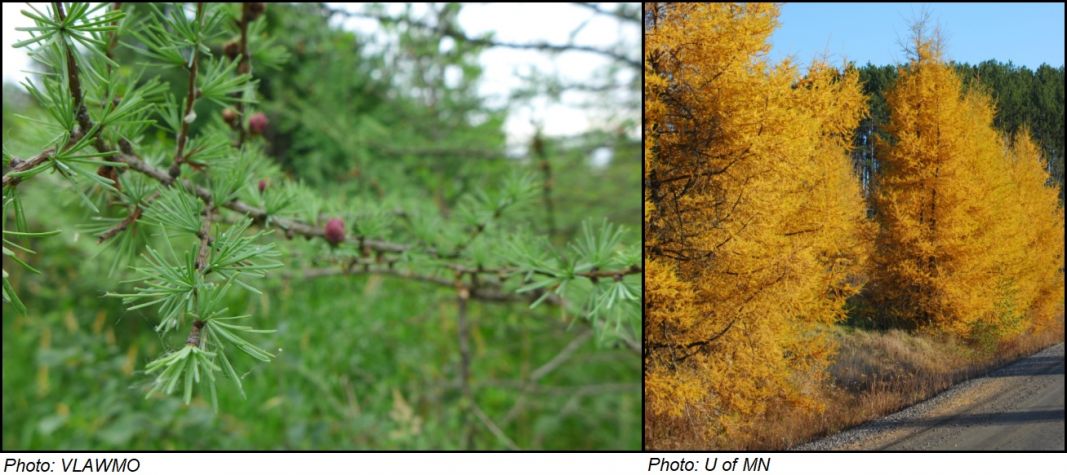Faces of Wetlands: Tamarack
Tamaracks are unique trees found in wet soils such as swamps, bogs, lakeshores. These trees grow up to 60’ high, have a shallow root system, and prefer sunny, open areas. One of the things that makes them unique is that they are deciduous conifers. In the fall, their needles turn a luminous gold and fall from the trees. When you see these trees with yellow needles and bare branches during fall and winter, it doesn’t mean that they are unhealthy; it’s all part of their annual cycle. However, very tall, old Tamarack trees are rare in Minnesota because of a large die-off due to larch sawflies.
Tamaracks are a pioneer species. After a disturbance in an area with wet soils, these trees will be among the first to take advantage of new light and move in. Because wetlands experience larger disturbance areas like die-offs or larger blow downs, tamaracks tend to grow in clumps or stands. Spotting this growth pattern is a fun way to be a detective, getting hints about the history of that wetland.
Tamarack’s growth pattern requires large landscapes with extensive bog and wetland habitats to allow seeds to disperse to new areas. Tamaracks were once common in the North metro, but development has reduced our wetlands and isolated them into separated pockets. As urban runoff increases, wetlands also receive more sediment. Large amounts of incoming sediment change the growing conditions, often leading to a plant community dominated by cattails and sumac.
Tamarack is an Algonquian word that means wood used for snowshoes. Early American settlers such as the Vadnais and Garceau families used tamarack as rot-resistant fence posts and housing frames. Early settlers also targeted tamarack for boat building. When a stump was cut high, a person could maneuver Tamarack’s shallow roots out of the ground still intact. The result was wood with a natural curve and the ability to withstand water. While some woods required laborious steaming and bending, this pre-bent tamarack root was perfect for building ship knees (curved pieces that run perpendicular to the keel). But tamaracks were even a learning tool for infrastructure as we know it. By laying poles end-to-end with 3” holes down the center, tamaracks were sometimes used as early municipal water lines.
Despite its history and even medicinal uses, it can be tough to value tamaracks. The wood is not commercially viable, and studies show that tamarack-dominated habitats are sparsely populated by wildlife (partly due to their ability to withstand extreme winters and having tricky seeds to crack). So are tamaracks just a relic of the past? As a tree of inhospitable wetlands, it could be easy to overlook them or even assume that they’re in opposition to a functional society. But what is history but a lesson for the present?

For the past two years, I lived in my departed Grandparent’s old house just south of Vadnais Lake. My hopes were to repair, restore, and eventually make it my long-term home. It would have completed three generations on the property. I spent hours restoring the basement, drainage system, and kitchen. I learned new skills and developed a deep fondness for the house and yard. It was challenging to improve a run-down, squirrel-infested place (especially when it seems like they’re winning). But with hard work, I grew and changed along with the house (even making peace with the squirrels). Unfortunately, the final property sale didn’t work out as I had hoped. As I packed up and moved out, it dawned on me that my experience here is a small reflection of the history of this entire neighborhood. The familiarity, the scenery of seasons changing, the work put in, the family names that are still local after generations, build a powerful sense of place. But you don’t feel this power when you’re in the thick of it. The chores, squirrel battles, and scheduling keeps attention off the scenery and the mind busy. But like the age old saying, you don’t really know what you have until it’s gone. If a tree could embody this lesson, I think it would be the silent tamaracks and their 60’ walls of blazing gold.
If we pause to notice them, perhaps tamaracks don’t have to be gone to be a symbol of home.
Here in VLAWMO the best spot to find tamarack trees is Tamarack Nature Center in White Bear Township. The Vadnais/Sucker Lake walking trail and numerous low-lying, wet places in North Oaks are also great options for tamarack-spotting. Try planting tamarack in that stubborn wet spot in the yard to save time and energy while adding scenic value.
Visit VLAWMO.org/get-involved to join a community of people working to build healthy wetlands and water resources, and to improve our understanding of the wonderful place we live in. Contact us at (651) 204-6070 for information on serving on our Citizen Advisory Committee, which helps guide and inform VLAWMO’s work. Additional opportunities are available as an Aquatic Invasive Species (AIS) detector.

